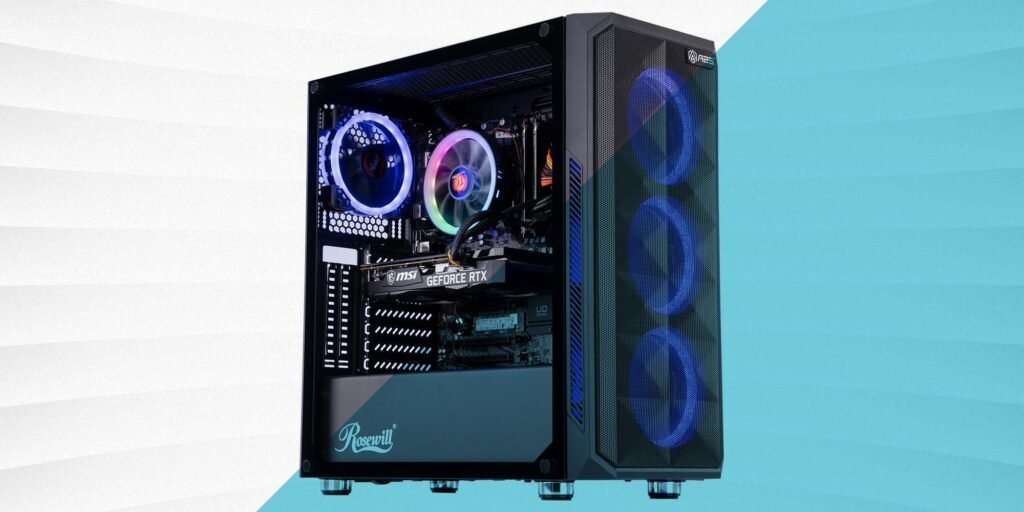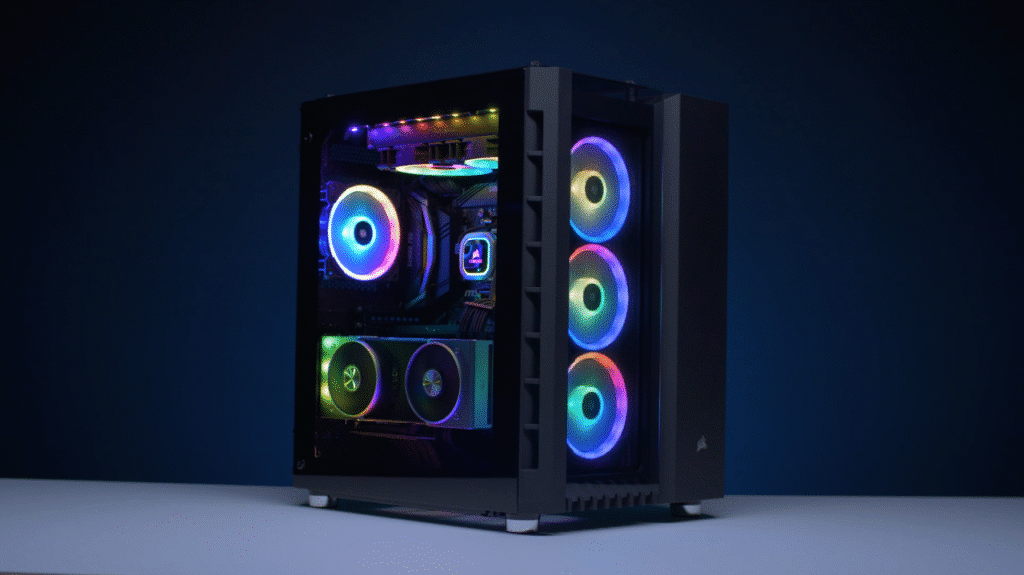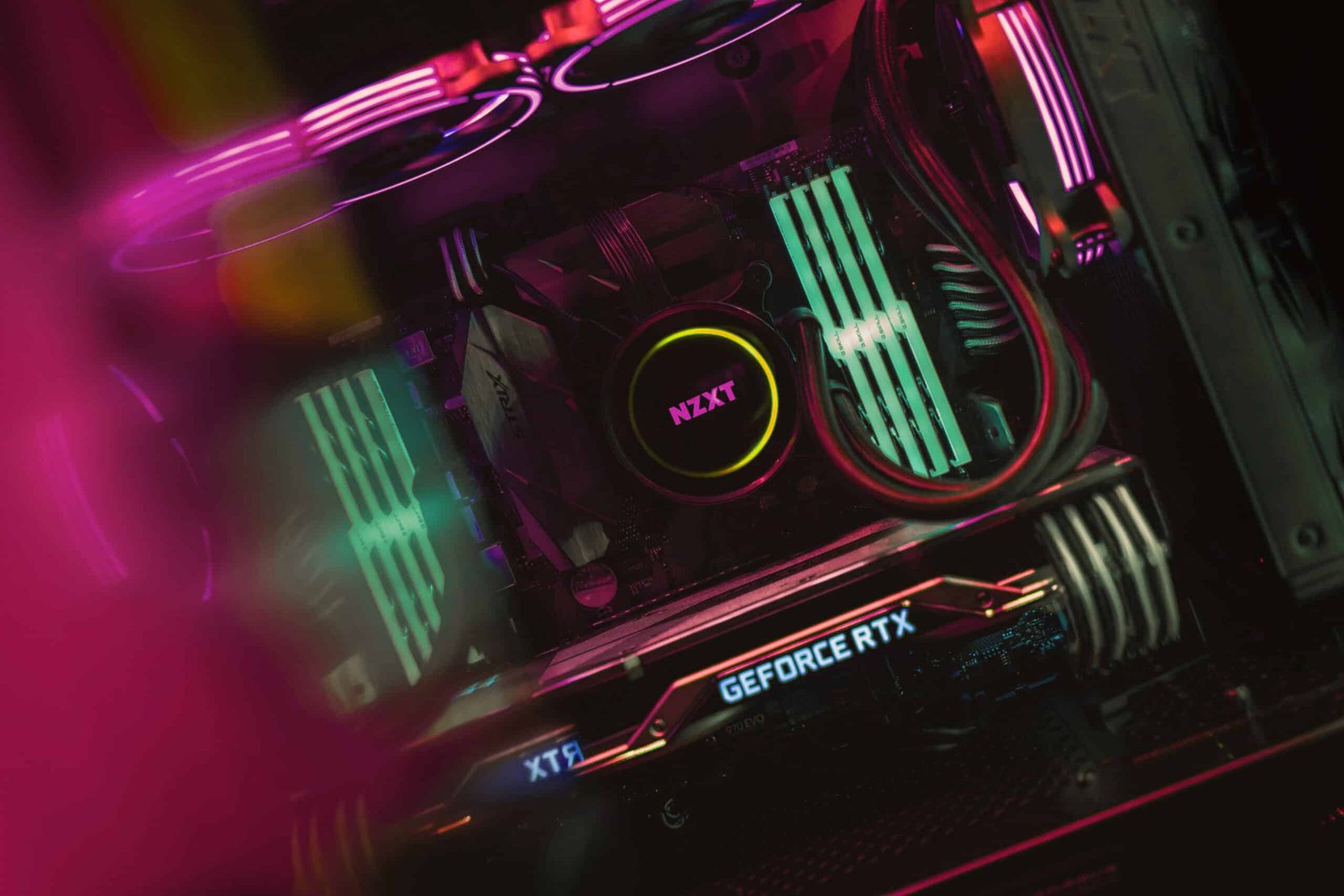The Ultimate PC Buying Guide in 2025
Welcome to The Ultimate PC Buying Guide (2025)
Building or buying the ultimate PC in 2025 requires more clarity than ever. The hardware landscape is crowded with incremental upgrades, confusing naming schemes, and price fluctuations that make it hard to gauge value.
Intel has introduced its Core Ultra processors built on the new Arrow Lake architecture, but in gaming, they actually perform slower than the older 14th-gen Core CPUs. Meanwhile, AMD launched its Ryzen 9000X3D lineup, which — unlike the rest of the Ryzen 9000 series — delivers real performance gains for gamers.
Nvidia also released its GeForce RTX 5000 series, but most models show only minor improvements over the previous generation. With today’s inflated GPU prices, their value for money is worse than before. AMD’s Radeon RX 9700 XT offers strong competition, though availability near MSRP varies by region. The upside? Timing isn’t an issue—six months ago was a good time to build, and the same still applies today.
For budget-conscious gamers, last year was arguably a better time to build a new PC. Still, compared to the GPU shortage from a few years ago — when a single graphics card cost as much as a full prebuilt system — the current market looks far more reasonable.
As usual, the GoPCmaster Buying Guide includes four component lists and builds with recommendations for different budgets and purposes…
Our recommendations reflect the best prices and availability at the time of writing. If any part of the list is out of stock or its price increases, don’t stress — each pick includes an explanation to help you choose the best alternative with confidence.
The Entry-Level PC

This setup handles everyday tasks with ease — from web browsing with multiple tabs to 1080p live streaming, light content creation, and entry-level gaming. If you’re still figuring out your exact needs, this build is a reliable starting point.
Component | Product | Price |
|---|---|---|
Processor | AMD Ryzen 5 8600G | |
Motherboard | Asrock B650M Pro RS | |
Memory | 32GB (2 x 16GB) DDR5-6000 CL30 | |
Storage | Samsung 990 Evo Plus 1TB | |
Graphics | Integrated / Radeon RX 6600 | |
PSU | Thermaltake Smart 500W | |
Case | Cooler Master Q300L V2 | |
Additional |
| |
| Core System Total | $555 |
For this build, we picked the Ryzen 5 8600G, which features powerful integrated graphics and delivers better value than the slightly pricier Ryzen 5 7600—a chip that’s more suited for systems with a dedicated GPU. With its 65W TDP, the 8600G stays cool using the stock cooler, as long as your case has good airflow.
When using integrated graphics, make sure your motherboard includes both DisplayPort and HDMI outputs for maximum monitor compatibility. The ASRock B650M Pro RS is a great fit here, offering solid thermals, four RAM slots, and three M.2 storage slots.
If you plan to upgrade with a dedicated graphics card later, the Radeon RX 6600 (around $220) offers the best value. Anything cheaper, like the GeForce RTX 3050 6GB, isn’t worth it at $190 due to much lower performance.
We went with a 32GB (2x16GB) DDR5 kit, which gives better long-term value than 16GB kits and avoids the need for costly upgrades later. For Zen 4 processors, DDR5-6000 remains the sweet spot for performance. Since prices for similar kits are close, go for the one with the lowest latency available.
For storage, the Samsung 990 EVO Plus provides excellent value — delivering speeds comparable to the Corsair MP600 Elite at a lower cost. It’s not the absolute fastest SSD you can buy, but it’s more than enough for most users.
Powering the system, the Thermaltake Smart 500W PSU offers 80 Plus efficiency and a 5-year warranty, making it a strong budget choice. Because this build uses an mATX motherboard, a compact mATX case is the smarter pick — a full-size ATX case would look too empty without a GPU.
The Cooler Master Q300L V2 stands out for its tempered glass panel and USB 3.2 Gen 2×2 Type-C support. If you prefer a flashier design, the Okinos Aqua 3 is a stylish alternative.
Monitor, Keyboard & Mouse
If you’re building this system mainly for work and everyday use rather than gaming, comfort and display quality matter most. The Dell S2725QS is an excellent 4K 120Hz monitor with adjustable height, tilt, and swivel. You can find more great options in our best monitors guide.
For peripherals, the Razer DeathAdder Essential mouse paired with the Logitech Wave Keys keyboard offers great performance for the price. Check out our curated lists of the best keyboards and best mice for more choices.
The Reliable Gaming Rig

This PC is built for gamers who want the best performance for their money in today’s latest titles, while keeping easy upgrade paths open for future hardware improvements.
Component | Product | Price |
|---|---|---|
Processor | AMD Ryzen 5 7600 | |
Motherboard | Asrock B650M Pro RS | |
Memory | 32GB (2 x 16GB) DDR5-6000 CL30 | |
Storage | Samsung 990 Evo Plus 1TB | |
Graphics | AMD Radeon RX 7600 XT | |
PSU | Thermaltake Toughpower GX2 | |
Case | NZXT H5 Flow (2024) | |
Additional |
| |
| Core System Total | $555 |
Compared to the Ryzen 5 8600G used in the previous build, the Ryzen 5 7600 delivers better overall performance with double the L3 cache, more PCIe lanes for the GPU, and full PCIe 5.0 support. The Ryzen 5 7600X and 9600X offer small performance gains but aren’t worth the extra cost for most users.
The ASRock B650M Pro RS stands out as one of the best-value B650 motherboards, offering excellent stability and support for future CPU upgrades.
The included Wraith Stealth cooler is serviceable, but replacing it with a more efficient option is a smart move. A dual-fan, single-tower cooler like the Thermalright Burst Assassin 120 Evo provides better thermals without taking up too much space.
For memory, a 32GB (2x16GB) DDR5 kit is ideal for modern gaming. Storage-wise, the SK Hynix P41 Platinum is a top-tier PCIe 4.0 SSD, delivering near-limit performance at a competitive price. It performs on par with the WD Black SN850X and Samsung 990 Pro, but was more affordable at the time of writing.
When it comes to graphics, the Intel Arc B570 is the lowest-end GPU worth considering for a modern setup, though its 10GB VRAM may limit longevity. A safer long-term pick is the AMD Radeon RX 7600 XT, featuring 16GB of VRAM and excellent 1440p performance. If the Radeon RX 9600 XT becomes available at a similar price, it would be the stronger choice — but that’s unlikely soon.
For power, the Thermaltake Toughpower GX2 delivers reliable performance with 600W output, 80 Plus Gold efficiency, and a 5-year warranty.
We housed the system in the NZXT H5 Flow (2024 version), chosen for its balance of airflow, build quality, and price. It also undercuts popular alternatives like the Corsair 4000D RS. If you’re placing your PC on a desk, the NZXT H6 Flow offers a shorter form factor and bottom-mounted connectors. You can find more affordable and well-built options in our best PC cases under $100 guide.
Monitor, Keyboard & Mouse
The Radeon RX 7600 XT handles 1440p gaming with ease — expect around 60 FPS at high settings or up to 120–180 FPS in lighter titles. The AOC Q27G3XMN is a great match, offering a 27-inch Mini-LED display that delivers premium visuals at a fair price.
Of course, there are many great monitors to choose from — check out our dedicated monitor buying guides for both productivity and gaming displays.
For peripherals, the Razer DeathAdder V3 remains a reliable choice for precision and comfort, while the Corsair K65 Plus offers excellent typing feel and build quality. You’ll find more tailored recommendations in our best mice and best keyboards roundups, suited to different budgets and preferences.
The High-end Gaming PC

This high-end gaming PC is designed for players who seek maximum performance and the latest features, not just the best value for their dollar. With today’s high-end GPUs, it delivers a smooth, powerful experience at both 1440p and 4K resolutions, making it perfect for gamers who want the best visuals and performance possible.
Component | Product | Price |
|---|---|---|
Processor | AMD Ryzen 7 7800X3D | |
Motherboard | Gigabyte B650 Aorus Elite AX | |
Memory | 32GB (2 x 16GB) DDR5-6000 CL30 | |
Storage | SK Hynix P41 Platinum 2TB | |
Graphics | AMD Radeon RX 9070 | |
PSU | Thermaltake Toughpower GF3 750W | |
Case | Cooler Master HAF 500 | |
Additional | Thermalright Burst Assassin 120 Evo | |
| $555 | |
Core System Total | $555 |
Compared to the Ryzen 5 8600G used in the previous build, the Ryzen 5 7600 delivers better overall performance with double the L3 cache, more PCIe lanes for the GPU, and full PCIe 5.0 support. The Ryzen 5 7600X and 9600X offer small performance gains but aren’t worth the extra cost for most users.
The ASRock B650M Pro RS stands out as one of the best-value B650 motherboards, offering excellent stability and support for future CPU upgrades.
The included Wraith Stealth cooler is serviceable, but replacing it with a more efficient option is a smart move. A dual-fan, single-tower cooler like the Thermalright Burst Assassin 120 Evo provides better thermals without taking up too much space.
For memory, a 32GB (2x16GB) DDR5 kit is ideal for modern gaming. Storage-wise, the SK Hynix P41 Platinum is a top-tier PCIe 4.0 SSD, delivering near-limit performance at a competitive price. It performs on par with the WD Black SN850X and Samsung 990 Pro, but was more affordable at the time of writing.
When it comes to graphics, the Intel Arc B570 is the lowest-end GPU worth considering for a modern setup, though its 10GB VRAM may limit longevity. A safer long-term pick is the AMD Radeon RX 7600 XT, featuring 16GB of VRAM and excellent 1440p performance. If the Radeon RX 9600 XT becomes available at a similar price, it would be the stronger choice — but that’s unlikely soon.
For power, the Thermaltake Toughpower GX2 delivers reliable performance with 600W output, 80 Plus Gold efficiency, and a 5-year warranty.
We housed the system in the NZXT H5 Flow (2024 version), chosen for its balance of airflow, build quality, and price. It also undercuts popular alternatives like the Corsair 4000D RS. If you’re placing your PC on a desk, the NZXT H6 Flow offers a shorter form factor and bottom-mounted connectors. You can find more affordable and well-built options in our best PC cases under $100 guide.
Monitor, Keyboard & Mouse
The Radeon RX 7600 XT handles 1440p gaming with ease — expect around 60 FPS at high settings or up to 120–180 FPS in lighter titles. The AOC Q27G3XMN is a great match, offering a 27-inch Mini-LED display that delivers premium visuals at a fair price.
Of course, there are many great monitors to choose from — check out our dedicated monitor buying guides for both productivity and gaming displays.
For peripherals, the Razer DeathAdder V3 remains a reliable choice for precision and comfort, while the Corsair K65 Plus offers excellent typing feel and build quality. You’ll find more tailored recommendations in our best mice and best keyboards roundups, suited to different budgets and preferences.
What Type of PC Do You Need?
Before diving into specs and parts lists, it’s important to figure out what you’re actually building or buying for. The ideal PC depends entirely on how you plan to use it—whether it’s high-FPS gaming, video editing, or just everyday tasks. Below are the most common use cases, each with its own performance priorities.
Prebuilt vs Custom PC
Once you know what kind of PC you need,
the next big decision is how you want to get it—buy it ready-made, or build it yourself.
Both prebuilt and custom PCs have their advantages, and the right choice depends on your budget, experience level, and priorities.
To help you decide quickly, here’s a side-by-side breakdown:
Prebuilt vs Custom — Pros & Cons
🖥️ Prebuilt PC | 🛠️ Custom Build | |
|---|---|---|
✔ Easy Setup | ✅ Ready out of the box | ❌ Requires time and effort |
🔧 Customization | ❌ Limited configuration options | ✅ Full control over every component |
💵 Price-to-Performance | ❌ Usually less value for the money | ✅ More performance per dollar |
🛡️ Warranty & Support | ✅ Included with system | ❌ Individual part warranties only |
🚀 Upgrade Flexibility | ❌ Often harder to upgrade | ✅ Designed to be upgraded easily |
🧠 Skill Level | ✅ Beginner-friendly | ❌ Requires basic hardware knowledge |
🖥️ Prebuilt PC | 🛠️ Custom Build |
|---|---|
✅ Ready out of the box | ❌ Requires time and effort |
❌ Limited configuration options | ✅ Full control over every component |
❌ Usually less value for the money | ✅ More performance per dollar |
✅ Warranty & Support included | ❌ Individual part warranties only |
❌ Often harder to upgrade | ✅ Designed to be upgraded easily |
✅ Beginner-friendly | ❌ Requires basic hardware knowledge |
Which One Should You Choose?
- Choose Prebuilt if you want something fast, hassle-free, and supported.
- Choose Custom Build if you’re after max performance, long-term flexibility, and a better price-to-performance ratio.
Desktop vs Laptop
Now that you’ve decided between prebuilt or custom, the next question is:
Should you go with a desktop or a laptop?
Both options have their place, but they serve very different needs. Whether you’re building for power, mobility, or future-proofing, understanding the trade-offs will help you choose the right form factor for your workflow or lifestyle.
🖥️ Desktop | 💻 Laptop | |
|---|---|---|
🔋 Portability | ❌ Stationary — not meant to move | ✅ Lightweight and mobile |
⚙️ Performance | ✅ More power per dollar | ⚠️ Limited thermals = lower sustained power |
🔧 Upgradeability | ✅ Easy to upgrade components | ❌ Mostly limited to RAM & storage |
🔋 Battery Dependence | ❌ Always plugged in | ✅ Runs on battery, great for mobility |
🧱 Size & Setup | ❌ Requires desk space & external peripherals | ✅ All-in-one, great for small spaces |
🖥️ Desktop | 💻 Laptop |
|---|---|
❌ Stationary — not meant to move | ✅ Lightweight and mobile |
✅ More power per dollar | ⚠️ Limited thermals = lower sustained power |
✅ Easy to upgrade components | ❌ Mostly limited to RAM & storage |
❌ Always plugged in | ✅ Runs on battery, great for mobility |
❌ Requires desk space & external peripherals | ✅ All-in-one, great for small spaces |
When to Choose a Desktop
- You want maximum performance for gaming, editing, or 3D work.
- You value upgradeability and longer system lifespan.
- You don’t need to move your setup often.
When to Choose a Laptop
- You need something portable for school, work, or travel.
- You prefer a cleaner, all-in-one setup.
- You’re okay with slightly less performance for the convenience.
Core Components Explained
Before you pick parts or buy a prebuilt, it helps to understand the core components that make up a PC. Each piece plays a specific role in performance, speed, and overall usability. Below is a quick breakdown of what each component does, what to look for, and where you can learn more.
Check out our guide on: How to build a PC from scratch?
